“Manhattan” is a Native American word meaning, "where timber is procured”, but what was the timber used for?
The Munsee-Delaware Native American language is no longer spoken today, but its legacy lives on in many places in the Northeast, including the financial capital of the world, Manhattan. Although the smallest and most densely-populated borough of New York City may now be the home of the world’s largest stock exchange, before becoming part of the U.S., Manhattan was merely a forest.
“Manhattan” was the first Native American place-name to be recorded by Europeans living in the area between Chesapeake Bay and the coast of Maine. According to oral tradition (as recorded in the 19th century) the island got its name due to a grove of hickory trees at its southern end that was considered ideal for the making of bows.
The name was first recorded in writing as “Manna-hata”, in the 1609 logbook of Robert Juet, an officer on Henry Hudson's yacht “Halve Maen” (Half Moon). A 1610 map confirms the name; the area is designated twice as “Manna-hata”, on both the west and east sides of the Mauritius River (now known as the Hudson River).
The name Itself derives from the Munsee Lenape language term “manaháhtaan” (“manah” means gather, and “aht” means bow). To the local indigenous people, the island was simply a place to gather the best timber for making bows and arrows. The word has been variously translated as "the place where we get bows" or "place for gathering the (wood to make) bows".
More Info:
en.m.wikipedia.org

